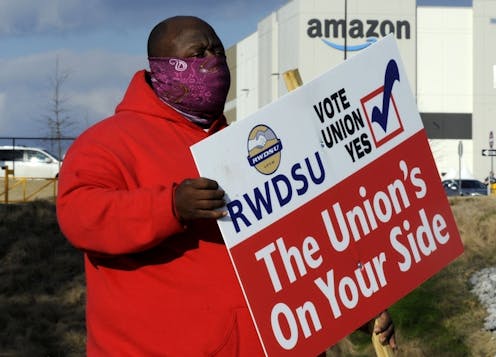Research shows labor unions help lower the risk of poverty
- Written by Tom VanHeuvelen, Assistant Professor of Sociology, University of Minnesota

The Research Brief[1] is a short take about interesting academic work.
The big idea
Belonging to a union or living in a U.S. state where organized labor is relatively strong helps lower the likelihood that you will fall into poverty, according to our new research.
In a peer-reviewed study[2], we examined how unionization is correlated with poverty. So we analyzed data on poverty and unionization rates from 1975 through 2015 using the Panel Study of Income Dynamics[3], which is widely considered to be the gold standard for tracking individuals over time. We used a variety of poverty measures in our analysis.
We found that households in which there was at least one union member had an average poverty rate of 5.9%, compared with 18.9% for nonunion households, based on a relative measure of poverty[4] rather than an absolute measure, by which what it means to be poor is fixed over time.
We also wanted to examine the impact of living in a state with a higher rate of unionization to see whether this broadly affected the likelihood that someone would be in poverty compared with states with lower union membership. Using the same relative measure of poverty, we found that states with higher unionization rates had average poverty levels about 7 percentage points lower than states with lower unionization rates.
Our findings imply that a 5 percentage point decline in Qunion membership translates, on average, into a 2 percentage point increase in the probability that a resident of the state will fall into poverty.
Why it matters
When policymakers and academics develop plans to address poverty, they rarely, to our knowledge, consider the impact of labor unions.
And yet research across social science disciplines show time and again that labor unions[5] have been central[6] to bolstering the[7] American middle class by raising wages and expanding access to fringe benefits.
Thus, it is logical, though rarely discussed, that unions would also reduce the risk that people become impoverished.
Our study also helps explain why the United States has a relatively high rate of poverty[8] – 18% as of 2017[9] – compared with other rich democracies[10]. France and the Norway, for example, boast poverty rates in the single digits as well as higher rates of union membership.
Our results suggest that had union membership not declined dramatically[11] since the 1970s, we could reasonably expect poverty rates would be significantly lower.
What’s next
We intend to conduct additional research, both within the United States and among other countries, to better understand the mechanisms linking unionization to poverty.
More broadly, the biggest open question is whether U.S. labor unions can expand their membership again and provide these types of protections against adverse economic forces.
[Over 106,000 readers rely on The Conversation’s newsletter to understand the world. Sign up today[12].]
References
- ^ Research Brief (theconversation.com)
- ^ peer-reviewed study (doi.org)
- ^ Panel Study of Income Dynamics (psidonline.isr.umich.edu)
- ^ relative measure of poverty (tcf.org)
- ^ labor unions (www.doi.org)
- ^ have been central (www.doi.org)
- ^ to bolstering the (doi.org)
- ^ high rate of poverty (www.doi.org)
- ^ 18% as of 2017 (data.oecd.org)
- ^ rich democracies (www.oecd-ilibrary.org)
- ^ not declined dramatically (www.oecd-ilibrary.org)
- ^ Sign up today (theconversation.com)
Read more https://theconversation.com/research-shows-labor-unions-help-lower-the-risk-of-poverty-161050

















